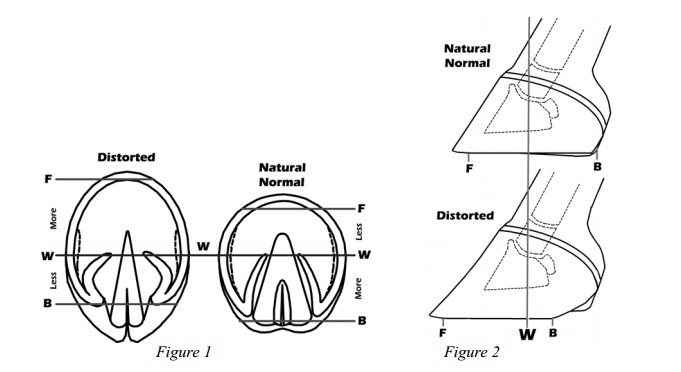A good step to begin with when doing hoof trimming is identifying hoof balance. What is a balanced hoof? A balanced hoof is a ‘natural hoof’ or a hoof that is trimmed to replicate the form of a natural hoof. What is a natural hoof? This is the hoof that you usually see on wild horses. These horses tend to have balanced hooves as they have a free roaming life style.
A balanced hoof has a hoof wall that supports not only the foot but also the entire body of the horse. The only part of the hoof that touches the ground is the ‘hoof wall’. In a balanced hoof, the frog area has the passive contact with the floor and the sole does not touch the floor.
A good point to ponder is from Jaime Jackson sharing “A balanced hoof is one whose size, shape, and proportion correspond precisely to its own unique, natural conformation.”
A Balanced Hoof:
- With its relationship with the coffin bone, a balanced hoof can provide balance to your horse’s skeleton system.
- It provides traction during the pull of the front hoof and push of the hind hoof.
- It services as a shock absorber by expanding and contracting.
- Pumps blood out of the foot when expanding and contracting.
- Promotes proper stride break over.
What to Look For?
Look at the hoof wall from its side view (see figure 2), and see if the angle of growth of the front hairline is similar with the angle of growth with the tip of the toe. Think of the angle of growth as a line and no matter what the line’s angle is, it should be a straight line. If there are changes in that straight line or a different angle is created then it is an indication that something not right is taking place.
Potential Indicators of Hoof Imbalance
1. Bruise or soreness around the toe wall – Any soreness or redness around the toe should tell you that something is wrong. There are other factors that can cause this problem, but for now consider hoof imbalance as the main factor. This is often just a minor issue that can be cured using regular hoof care and hoof balance methods so do not go into major methods right away such as shoes or invasive trimming methods.
4. Unnatural Hoof Wall Wear Patterns – Generally, a naturally balanced hoof will possess 3 or 4 points of positive contact with the floor. Two of these points in contact are located at the heal buttresses and the rest of the points in contact will be at or close to the toe. These points of contact are the most active when it comes to growth. As these points get the most floor contact, they wear faster yet grows faster compared to areas that only have passive ground contact.
3. Growth Lines’ Deviation – The Hoof Wall’s Growth Lines Need to Be Perpendicular to the Floor. Any deviation of the growth lines is an indication of hoof imbalance or abnormal growth. The deviation can be a result from improper trimming or shoeing methods and unnatural wearing conditions.
2. Elevated Heel – The horse’s heel is directly proportional with the angle of growth. Heels that are too high, incorrectly trimmed or on the shod horse will have a negative effect on the natural angle of growth of hooves. The heels need to be maintained short so the frog will have passive contact with the ground.
Frogs that are uneven and narrow tend to become rubbery and damp near the sole which is why frogs need to be kept flat and wide. The frog should only passively touch the ground and not have the full pressure against it. The frog is a sensitive area and it helps your horse know where on the ground its hooves are with just a minor contact. Properly trimming the heels will allow the frog to wear naturally and maintain the right sensitivity.
A good way to evaluate the horse’s balance is to observe how it moves on its own or without a rider. It is hard to clearly see the imbalance if someone is riding the horse especially if that someone is a novice and is the main cause of the struggle. A horse with a naturally balanced hoof will move naturally, freely and swiftly.
